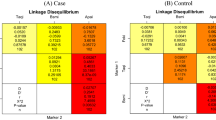Abstract
The 3′ untranslated region of the water buffalo Nramp1 (natural resistance-associated macrophage protein 1) gene contains two alleles (Nramp1A and Nramp1B), as detected by the denaturing gradient gel electrophoresis (DGGE) technique. The Nramp1BB genotype is associated with resistance of water buffalo to the intracellular pathogen Brucella abortus. This article provides evidence that the Nramp1AA genotype is associated with susceptibility to the same pathogen. Susceptibility or resistance of water buffalo to B. abortus was established by agglutination, complement fixation, and skin tests. The Nramp1 genotype was established by DGGE analysis. The association between the Nramp1AA genotype and susceptibility to B. abortus was demonstrated in two independent population samples (152 cases and 281 controls; 87 cases and 124 controls, respectively). Macrophages from Nramp1AA subjects displayed a lower Nramp1 mRNA level when compared with macrophages from Nramp1BB subjects. Also, monocytes and macrophages from Nramp1AA subjects displayed a higher number of viable intracellular bacteria in comparison with monocytes and macrophages from Nramp1BB animals, providing biological significance to the results from association studies.



Similar content being viewed by others
References
Allison AC (1954) Protection afforded by the sickle-cell trait against subtertian malarial infection. Br Med J 1, 290–294
Anonymous (1999) Freely associating. Nat Genet 22, 1–2
Alton GG, Jones VH, Pietz DE (1975) Laboratory techniques in brucellosis, WHO Monogr Ser 55. (Geneva: World Health Organization), pp 64–124
Barthel R, Feng J, Piedrahita JA, MacMurray DN, Templeton JW, et al. (2001) Stable transfection of the bovine NRAMP1 gene into murine RAW264.7 cells effects on Brucella abortus survival. Infect Immun 69, 3110–3119
Bird TD, Jarvik GP, Wood NW (2001) Genetic association studies. Neurology 57, 1153–1154
Borriello G, Capparelli R, Bianco M, Fenizia D, Alfano F, et al. (2006) Genetic resistance to Brucella abortus in the water buffalo (Bubalus bubalis). Infect Immun 74, 2115–2120
Capparelli R, Ventimiglia I, Roperto S, Fenizia D, Iannelli D (2006) Selection of an Escherichia coli O157:H7 bacteriophage for persistence in the circulatory system of mice infected experimentally. Clin Microbiol Infect Dis 12, 248–253
Cavalli-Sforza LL, Bodmer WF (1971) Mendelian populations. In The genetics of human populations (San Francisco: W.H. Freeman), pp 39–70
Cellier M, Prive G, Belouchi A, Kwan T, Rodriguez V, et al. (1995) The natural resistance associated macrophage protein (Nramp) defines a new family of membrane proteins conserved throughout evolution. Proc Natl Acad Sci USA 92, 10089–10094
Dixon DA, Kaplan CD, McIntyre TM, Zimmerman GA, Prescott SM (2000) Post-transcriptional control of cyclooxygenase-2 gene expression. J Biol Chem 275, 11750–11757
Garcia-Crespo D, Juste RA, Hurtado A (2006) Selection of ovine housekeeping genes for normalization by real-time RT-PCR analysis of PrP gene expression and genetic susceptibility to scrapie. BMC Vet Res 2, 26
Godfroid JC, Saegerman C, Wellemans V, Walvaren K, Letesson J, et al. (2002) How to substantiate eradication of bovine brucellosis when aspecific serological reactions occur in the course of brucellosis testing. Vet Immunol 90, 461–477
Ioannidis JP, Ntzani EE, Trikalinos TA, Contopoulos-Ioannidis DG (2001) Replication validity of genetic association studies. Nat Genet 29, 306–309
Kathiresan S, Newton-Cheh C, Gerszten RE (2004) On the interpretation of genetic association studies. Eur Heart J 25, 1378–1381
Lander ES, Schork NJ (1994) Genetic dissection of complex trait. Science 265, 2037–2048
Lee WC (2003) Searching for disease-susceptibility loci by testing for Hardy-Weinberg disequilibrium in a bank of affected individuals. Am J Epidemiol 158, 397–400
Lohmuller KE, Pearce CL, Pike M, Lander ES, Hirschorn JN (2003) Meta-analysis of genetic association studies supports a contribution of common variants to susceptibility to common diseases. Nat Genet 33, 177–182
Nielsen K, Smith P, Widdison J, Gall D, Kelly L, et al. (2004) Serological relationship between cattle exposed to Brucella abortus, Yersinia enterocolitica O:9 and Escherichia coli O157:H7. Vet Microbiol 100, 25–30
Pappas G, Papadimitriou P, Akritidis N, Christpu L, Tsianos EV (2006) The new global map of human brucellosis. Lancet Infect Dis 6, 91–99
Price RE, Templeton JW, Smith R III, Adams LG (1990) Ability of mononuclear phagocytes from cattle naturally resistant or susceptible to brucellosis to control in vitro intracellular survival of Brucella abortus. Infect Immun 58, 879–886
Pritchard JK, Rosenberg NA (1999) Use of unlinked genetic markers to detect population stratification in association studies. Am J Hum Genet 65, 220–228
Rotter JJ, Diamond J (1987) What maintains the frequencies of human genetic diseases? Nature 329, 289–290
Watarai M, Kim S, Erdenebaatar J, Makino S, Horiuchi M, et al. (2003) Cellular prion promotes Brucella infection into macrophages. J Exp Med 198, 5–17
Weir BS (1996) Disequilibrium. In Genetic data analysis II: methods for discrete population data (Sunderland, MA: Sinauer Associates), pp 91–139
Zaharik ML, Vallance BA, Puente JL, Gros P, Finlay BB (2002) Host-pathogen interactions: Host resistance factor Nramp1 up-regulates the expression of Salmonella pathogenicity island-2 virulence genes. Proc Natl Acad Sci USA 26, 15705–15710
Acknowledgments
The authors are grateful to two anonymous referees for their stimulating suggestions. The experiments comply with current Italian legislation. The work was funded by the Regione Campania.
Author information
Authors and Affiliations
Corresponding author
Rights and permissions
About this article
Cite this article
Capparelli, R., Borriello, G., Marabelli, R. et al. The Nramp1AA genotype confers susceptibility to Brucella abortus in water buffalo. Mamm Genome 18, 137–143 (2007). https://doi.org/10.1007/s00335-006-0103-x
Received:
Accepted:
Published:
Issue Date:
DOI: https://doi.org/10.1007/s00335-006-0103-x




